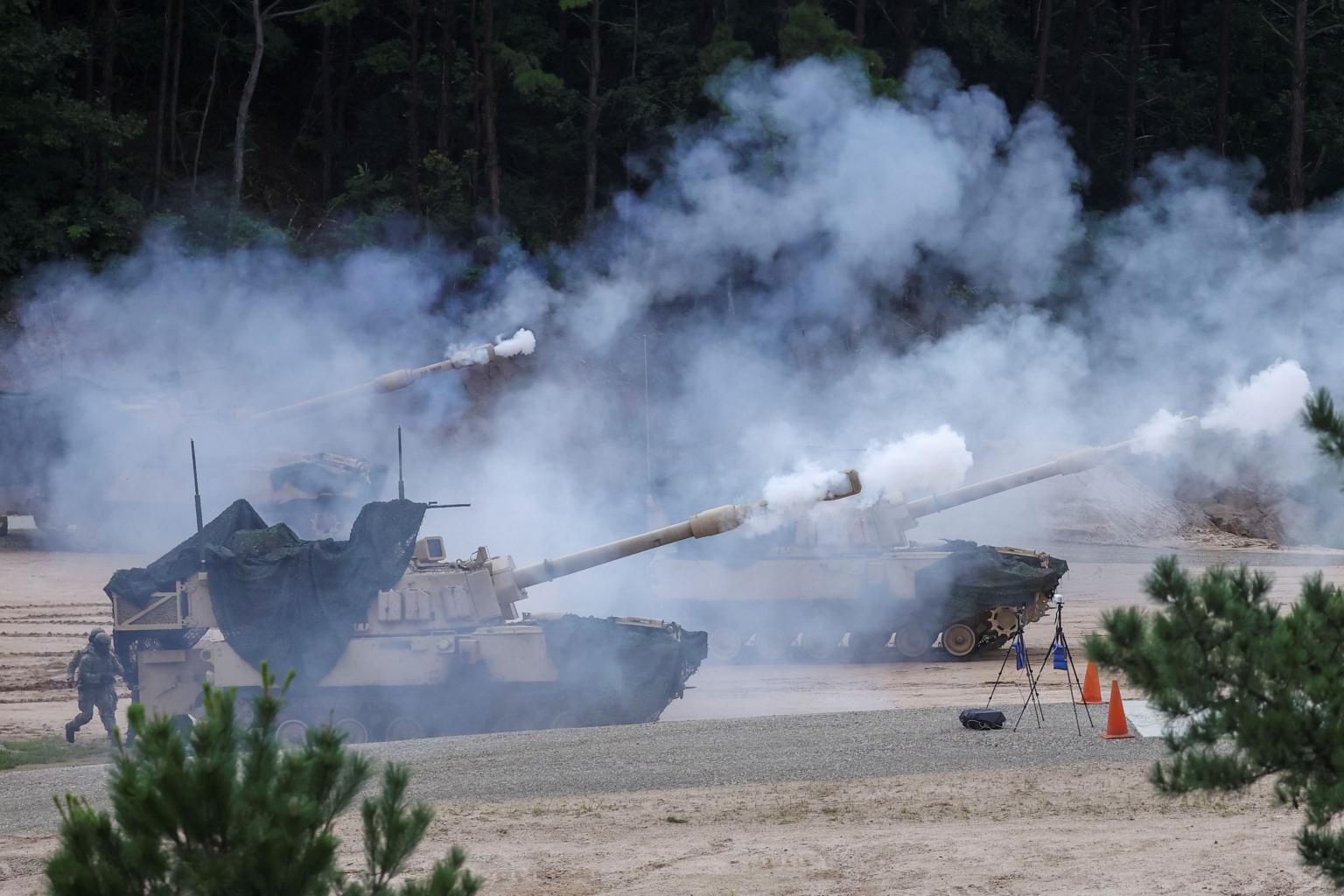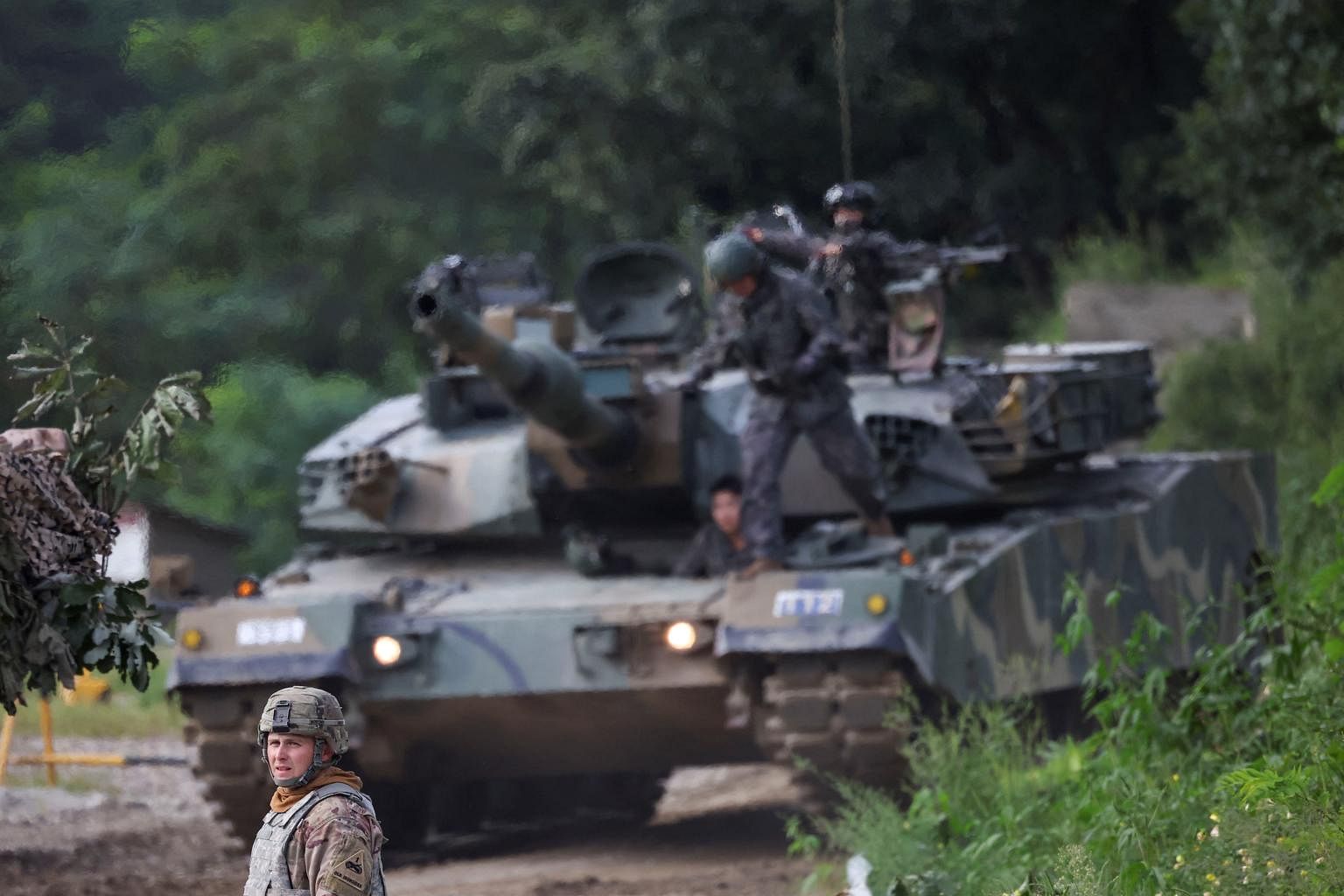US, South Korea stage largest combined military drills in years
Sign up now: Get ST's newsletters delivered to your inbox

The drills were designed to simulate battling a near-peer enemy who could match the allies in capabilities.
PHOTO: REUTERS
Follow topic:
POCHEON, SOUTH KOREA (REUTERS) - Tanks and howitzers sent smoke and shockwaves through the air less than 32km from the fortified border with North Korea on Wednesday (Aug 31), as more than 1,000 South Korean and US troops held a major live-fire exercise in stepped up practice for war.
South Korea and the United States have resumed the largest field exercises in years after diplomatic efforts and Covid-19 restrictions led to many drills being scaled back.
The allies see the exercises as a key part of their efforts to deter North Korea and its growing nuclear arsenal, but North Korea has called them a rehearsal for war and they have faced criticism even in South Korea and the US.
Reuters was among a handful of media granted rare access to the drills on Wednesday.
They were the first division-level exercises for the 2nd Infantry Division/ROK-US Combined Division, the US military’s only multinational division formed in 2015. ROK are the initials for South Korea’s official name.
The drills included live fire from American and South Korean howitzers, tanks, machine guns and mortars. American A-10 attack aircraft and Apache helicopters also participated.
Rounds from howitzers pounded into a mountainside at the Rodriguez Life Fire Complex, as tanks from both sides manoeuvred and fired their guns at targets, sending shockwaves across the valley and smoke and dust into the air.
Colonel Brandon Anderson, the division's deputy commander for manoeuvre, said the drills were not aimed at any one adversary, but they obviously took into account the "reason for the US-ROK alliance" - alluding to North Korea.
“We’re all here for a reason, we all know that’s a potential (threat), and how we would defend against it is what we’re trying to demonstrate here,” he said, adding that the drills underscore that U.S. forces won’t be leaving the peninsula.
“We are here for the long haul. As long as there is a threat out there, it gives us purpose, and purpose to train.”
The United States has about 28,500 troops in South Korea.
The drills also form part of the US military’s recent efforts to refocus on large-scale combat operations, and were designed to simulate a counter-attack against a “near-peer” enemy who could match the allies in capabilities, Anderson said.
The conflict in Ukraine had provided lessons on the importance of alliances and the need to improve long-range artillery and surveillance and reconnaissance capabilities, he added.
‘Smooth cooperation'
US Army Staff Sergeant John Moreno, who commanded one of the M1A1 main battle tanks in the exercise, said it was only the second time in his crew’s nine-month deployment that they had fired their main guns, and the first time doing it with their South Korean counterparts, who operated from their K2 tanks on the range at the same time.
“It keeps the soldiers well trained to fire as often as possible,” he said, adding that cooperation with the South Koreans went smoothly – an important factor if war with the North ever broke out.
Anderson denied that these drills were among those delayed for political reasons but said Covid-19 and the logistical challenges of pulling off a multinational exercise with live ammunition meant the allies had been unable to conduct the practice until now.
The restrictions were a blessing in disguise as it allowed the troops to develop expertise at the individual and small-unit levels, Anderson said.
“This is the first time to really bring them all together, over 1,000 people,” he said.

South Korean General Kim Nam-hoon, deputy commander of the combined division, said the troops would improve their ability to operate together through joint drills.
Many large exercises were cancelled starting in 2018 as then-US president Donald Trump tried to persuade North Korean leader Kim Jong Un to give up his nuclear weapons. Covid-19 later disrupted more drills.
A former senior defence official told Reuters that in many cases US and South Korean forces continued to train but did not publicise it.
That has changed, with both the United States and South Korea increasingly touting their alliance in the face of increased missile tests by North Korea, and the prospect of it testing another nuclear weapon.
This week, North Korea gathered commanding officers of its paramilitary civil defence forces for training on “full preparations for all-people resistance in our country where a constant threat of war lingers”, state media reported on Wednesday.

